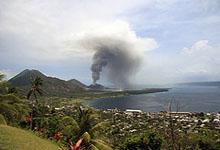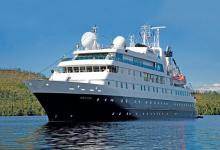Recently Viewed Cruises
- Orion, West Papua & Maluku ex Rabaul to DarwinAdd to favourites
- Orion, Papua New Guinea Cultural Highlights ex Cairns to RabaulAdd to favourites
- Yangzi Explorer, Downstream ex Chongqing to YichangAdd to favourites
- Yangzi Explorer, Upstream ex Yichang to ChongqingAdd to favourites
- True North, Kimberley Islands Cruise Southern ex Hunter River to BroomeAdd to favourites
- Catch up on Cruising: Latest cruise news in bite size
- Oceania puts the flags out for Insignia
- Luxury cruising booms
- Catch up on Cruising: Latest cruise news in bite size
- Royal Caribbean International raises the bar
- Frequently Asked Questions
-
Orion, West Papua & Maluku ex Rabaul to Darwin
Nights 11 Ship Orion Star Rating 
Departs Rabaul, Papua New Guinea Sailing 2013: 7 Apr Ports of Call Rabaul, Wewak, Jayapura, Papua New Guinea, Yamdena Island, Darwin Select a sailing date for approximate pricing.
Prices are per person, twin share. When booking please check current cruise fare and inclusions. Prices are indicative only, subject to currency fluctuations and may change at any time without notice.
11 Night Cruise sailing from Rabaul to Darwin aboard Orion.
Join us for this exciting circumnavigation of Papua, a largely inaccessible territory previously known as Irian Jaya. We sail these rarely travelled blue waters out and over "the birds head" of West Papua to visit remarkable islands. Until you see the exotic peoples of these islands first-hand, you won't believe their mysterious ceremonies. These derive from a thousand cultures and centuries of tradition and superstition from the archipelagos and atolls that stretch from Rabaul, North West through to the Northern Territory. The landscape is breathtaking. This province contains the highest mountains between the Himalayas and the Andes, rising up to 4884m high. The vast southern and northern lowlands, stretching for hundreds of kilometres, include lowland rainforests, extensive wetlands, savannah grasslands, and some of the largest expanses of mangrove forest in the world, providing a home to some remarkable wildlife. Around the tip we visit Raja Ampat, an archipelago of over 1,500 small islands, cays and shoals surrounding four main islands. We then sail south to Maluku, a rarely visited group of islands. This is a one-off adventure for Orion and her crew and sure to be in high demand as it affords a rare opportunity to visit one of the world's last great unexplored sea wilderness areas.
Highlights of this cruise:
Rabaul
Set at the eastern end of the island of New Britain, the tropical port town of Rabaul has always been famous for its spectacular setting. Nestled beside Simpson Harbour, the township is surrounded by six volcanoes, one of which, Mt Tavurvur, is still active today. During more than 100 years of settlement, Rabaul has been rocked by massive volcanic eruptions and war, a testament to the resilience of the townsfolk who have rebuilt after each event.
The most recent major volcanic eruption was in September 1994 when Tavurvur and Vulcan covered much of Rabaul and surrounding villages with volcanic ash. This eruption saw the growth of the nearby coastal town of Kokopo which has now become the administrative and tourism centre for East New Britain, replacing Rabaul in that role..
The area played a significant role in WWII and the Japanese occupation in 1942 saw the building of hundreds of kilometres of tunnels underneath the town and the Gazelle Peninsula as protection against constant Allied bombing raids. It is almost hard to miss the rusting relics left over by the retreating forces. In one tunnel are five huge barges that were pulled along rails to the shore and back by prisoners of war. Dozens of sunken aircraft and ships dot the harbour and to the north are sea caves used as a drop-off point by Japanese submarines.
Wewak
Set at the eastern end of the island of New Britain, the tropical port town of Rabaul has always been famous for its spectacular setting. Nestled beside Simpson Harbour, the township is surrounded by six volcanoes, one of which, Mt Tavurvur, is still active today. During more than 100 years of settlement, Rabaul has been rocked by massive volcanic eruptions and war, a testament to the resilience of the townsfolk who have rebuilt after each event.
The most recent major volcanic eruption was in September 1994 when Tavurvur and Vulcan covered much of Rabaul and surrounding villages with volcanic ash. This eruption saw the growth of the nearby coastal town of Kokopo which has now become the administrative and tourism centre for East New Britain, replacing Rabaul in that role..
The area played a significant role in WWII and the Japanese occupation in 1942 saw the building of hundreds of kilometres of tunnels underneath the town and the Gazelle Peninsula as protection against constant Allied bombing raids. It is almost hard to miss the rusting relics left over by the retreating forces. In one tunnel are five huge barges that were pulled along rails to the shore and back by prisoners of war. Dozens of sunken aircraft and ships dot the harbour and to the north are sea caves used as a drop-off point by Japanese submarines.
Yamdena Island - Wet Landing
Today we will visit the village of Sangliat Dol and also Weluan Beach, both on Yamdena Island in the Tanimbar group of islands. (Please note that the sequence of visit may change due to tidal factors)
This traditional village in the Tanimbar islands is the centre of the ancient "boat" culture of Maluku. In the centre of the village is a stone boat. Not a boat that was ever meant to float, but a boat built to symbolise the arrival from the sea of the original inhabitants of Maluku. Most villages simply abandoned their giant stone boats and the culture that was attached when they were moved to the coast. But Sangliat Dol was different. Although on the coast a steep rise starting immediately from the foreshore meant that the original village built for safety and security on the hill top, was already close to the coast. The village of Sangliat Dol was therefore not required to move during the colonial period and the legacy of that is their giant stone boat and the culture associated with it remains intact today. A giant stone stair case leads from the beach to the hill top ceremonial area. The village structure still follows the organisation of a boat today. The village head is seen as the Captain or Master "steering" the direction of the village. Many other positions of the village basically translate as "helmsman" "harpooner" "bailer boy" and other boat related names. There are two further figures in the structure the "herald" or "speaker" who is the father of the village and speaks for the village (traditionally basically in times of war) and the "sacrificer" or mother of the village. The mother and father of the village represent the cooperation as in a marriage to ensure the continuing existence of the village. For our visit and for other important events a massive ritual takes place surrounding the stone boat. Traditionally all village decisions would revolve around such a ceremony.
Darwin
Darwin is Australia's closest city to the equator and the gateway to the Top End. Following bombing during World War II, Darwin was more a frontier town of crocodile and buffalo shooters and pioneer cattlemen. After the city was wiped out by Cyclone Tracy in 1974 it was rebuilt as Australia's cosmopolitan northernmost tropical capital. Beyond the city lies Litchfield National Park (about 2 hours drive) and to the south-east the teeming wetlands of Australia's largest national park, Kakadu. Much architecture remains from the city's early periods, with museums, markets and an incredible diversity of restaurants to keep visitors entertained. The harbour foreshore area is a great place to discover the city's maritime links. Take a relaxing cruise on an old pearl lugger, a thrilling flight in a seaplane or a gentle hovercraft trip. Spend a day out fishing for barramundi, jewfish, golden snapper and threadfin salmon, or go for the adventure of scuba diving around shipwrecks. At sunset, savour a taste of Asia's night markets at Mindil Beach, where you can browse the food stalls for a picnic dinner on the beach.







